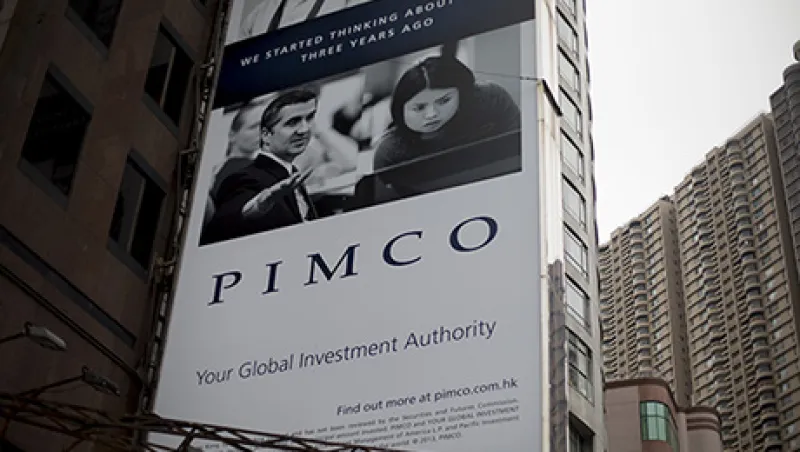For anyone worried that the fixed-income market is broken, co-founder Bill Gross’s September departure from Pacific Investment Management Co. offered no solace. By month’s end bond giant PIMCO had suffered $25.5 billion in net outflows, according to Chicago-based research firm Morningstar. Those assets poured into an increasingly illiquid market in which rules that banks must hold augmented capital have prompted broker-dealers to slash bond inventories.
To make matters worse, investors in corporate credit still shun electronic trading for the largest and most important trades. Many of them cling to the past by picking up the phone and placing orders on a principal basis, which requires dealers to put up now-scarce capital. Historically low interest rates and the continued appetite for bond funds help keep managers in denial. Dealers are good at distributing new issues to buyers, but they have yet to be tested when the flow goes in the other direction.
“For the time being, benign conditions hide the flaw, and market participants fail to institute changes to address the problem,” Anthony Perrotta, New York–based head of fixed income with research firm TABB Group, wrote in an October report on illiquidity in the corporate bond market. “This is especially true of the investment management community, which is reluctant to initiate the changes that will break its dependence on the principal-based model.”
As dealers have retrenched, some innovative electronic solutions have emerged. Last year MarketAxess Holdings, an automated platform for corporate bonds that emerged from J.P. Morgan & Co.’s LabMorgan Corp. incubator in 2000, formed a strategic partnership with BlackRock. The world’s largest money manager connected its Aladdin Trading Network, an investment system used by BlackRock and outside clients for order flow, to New York–based MarketAxess’s e-trading platform.
This Open Trading initiative turns the traditional paradigm on its head by allowing dealers and investors to share their orders as broadly as they like. If Prudential Financial, for instance, wants to buy some bonds that Loomis, Sayles & Co. is trying to sell, the two firms can connect and have the trade cleared by any dealer on the platform.
“It’s an enormous behavioral change, for investors in particular,” says Richard McVey, who has been chairman and CEO of MarketAxess since its inception. “It will take time, but the adoption rates are encouraging.”
During the second quarter of 2014, the number of clients using Open Trading protocols grew roughly 49 percent, from 175 firms to 260. The new model is a product of the times. “In the days when dealers had plenty of capital and could hold huge inventories of bonds just waiting around for buyers and sellers, MarketAxess’s Open Trading initiative likely would not have gotten off the ground,” says Michael Chuang, CEO of iTB Holdings, a New York–based provider of software that connects professional traders to the electronic fixed-income venues of their choice.
What dealers get from Open Trading is the ability to do trades on a lower-fee, riskless, agency basis (clearing the trade when two managers find each other independently). They can also do principal trades by putting up capital.
McVey emphasizes that the changed environment is driving everybody to find a solution. “The liquidity risk in corporate bonds has shifted to investment managers who are holding the vast majority of the debt,” he says. “Due to regulatory changes, dealers no longer have the balance sheet to serve as a buffer when the market environment shifts.”
Electronic trading has grown substantially since the financial crisis. Not counting dealer-to-dealer trading, MarketAxess has a roughly 20 percent share of secondary customer market volume in U.S. corporate credit. Compare that with traditional dealer J.P. Morgan Chase & Co., whose market share is 14.2 percent, according to Greenwich Associates, a research firm based in Stamford, Connecticut.
E-trading has also created new sources of liquidity. MarketAxess has added 50 dealers to its platform since the crisis, largely because investors pushed the platform to add new trading sources. Those dealers, many of which spun off from the big firms, now account for 30 percent of MarketAxess’s volume.
Other electronic trading outfits are sniffing opportunity too. Investment Technology Group, a New York–based stock trading and technology firm, recently announced that it’s launching a dark pool, a private alternative to an exchange, for fixed income by the end of the year. New York–based Liquidnet Holdings finalized its purchase of Vega-Chi, a London-based electronic platform founded by a former Goldman Sachs Group trader, in August and plans to offer a credit trading network in addition to its private stock market.
The number of investors trading at least some of their bonds electronically has jumped 70 percent since 2009, notes Kevin McPartland, head of market structure and technology advisory at Greenwich Associates. In the past five years the proportion using e-trading has climbed from 47 percent to 80 percent. About one third of smaller institutional bond trades — so-called odd lots, between $100,000 and $1 million in size — take place electronically, according to McPartland.
But institutional block trades, those between $1 million and $25 million, are less frequently done with a machine. McVey says trades worth $5 million and more have been elusive for MarketAxess, but he expects the Open Trading effort will help change that.
Investors are reluctant to display their corporate-bond block orders broadly, fearing that information will leak to the market and foil their efforts to get good prices. With Open Trading, however, dealers and investors can display indications of interest to find potential trade matches. Once a match is identified, the two can negotiate price and size privately, limiting information leaks.
To tap new electronic trading sources, money managers need to make faster decisions and be much more active in the markets than they have in the past. There are signs of change. For example, managers are hiring sell-side traders used to responding to opportunities all day. They’re also giving traders the flexibility and authority to buy or sell bonds that meet a manager’s requirements but might not be an exact match.
Despite the success of electronic trading and the innovative thinking behind efforts such as MarketAxess’s Open Trading, it’s still early days — and trade automation won’t soften the blow of illiquid fixed-income markets once investors start selling in a market correction.
“You have all these nascent efforts to get people to trade more electronically,” says Laird Landmann, one of a team of four that oversees U.S. fixed income at $140 billion–plus asset manager TCW Group. “But electronic trading is not going to save you.” His fellow team member Bryan Whalen agrees, saying, “There is this false hope that asset manager A will provide asset manager B with liquidity, and vice versa. That’s not going to happen.”
But if Wall Street isn’t there to cushion the markets when interest rates inevitably rise, firms like Los Angeles–based TCW are happy to step in. Because TCW’s managers are value investors, Landmann stresses, they will benefit from illiquid and volatile markets by purchasing mispriced securities. As bond prices have risen, the firm has been trading into more-liquid agency securities and Treasuries, so it has enough cash on hand to buy into a market correction.
Today’s illiquid fixed-income markets are part of a big behavioral shift that has been afoot since the 1980s, Landmann notes: “When Salomon Brothers was a private firm, it stepped in to buy bonds when markets went mad, regardless of what the activity did to its earnings in the short term.”
But Salomon became more risk-averse once it went public and became subject to scrutiny of its quarterly earnings. After hedge fund firm Long-Term Capital Management needed a bailout in 1998, Wall Street further retreated from risk, adopting value-at-risk models, which essentially advise selling securities when volatility is high and buying when it’s low, the opposite of value management.
Landmann says the 2013 Volcker Rule, which prohibits banks from proprietary trading, is a “mean joke.” Under Volcker, banks can’t play their traditional role of stepping in to buy securities during rough periods. “It’s like tightening the shock absorbers on my 14-year-old’s dirt bike and saying, ‘Try that bump right there,’” Landmann explains. “You don’t know if you’re going over the handlebars or not when you hit that bump.”
Adds his colleague Whalen: “We’ve pushed the pendulum too far. We’ll have to see the repercussions before it swings back the other way.”
Follow Julie Segal on Twitter at @julie_segal.
Get more on fixed income.







